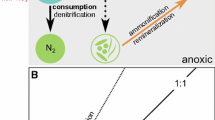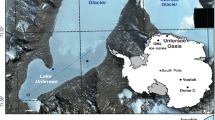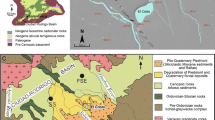Abstract
Biogeochemical dynamics under seasonal ice cover were investigated in the shallow (<10 m) water column of highly productive Georgetown Lake, western Montana, USA. This high altitude (1,800 m) reservoir is well-mixed in summer, but becomes strongly stratified under ice cover (mid-November–mid-May). A rapid drop in dissolved oxygen (DO) concentration and rise in dissolved inorganic carbon (DIC) concentration was observed after the onset of ice, with a corresponding increase in δ18O-DO and decrease in δ13C-DIC, likely caused by respiration (R) of organic carbon. Photosynthesis/respiration ratios (P/R) estimated from simultaneous measurement of DO and δ18O-DO were near unity prior to ice formation but then systematically decreased with time and depth in the lake under ice cover. P/R in the water column was higher at a shallower monitoring site compared to a deeper site near the dam outlet, which may have been important for over-winter survival of salmonids. By March, the bottom 3 m of the water column at both sites was anoxic, with the bottom 1 m being euxinic. Elevated concentrations of dissolved sulfide, ammonium, phosphate, Fe2+, and Mn2+ in deep water suggest coupling of organic carbon degradation with reduction of a number of electron acceptors (e.g., Fe3+, \({\text{NO}}_{3}^{ - } ,\;{\text{SO}}_{4}^{2 - }\)). The concentrations and δ34S values of H2S in the deep water and \({\text{SO}}_{4}^{2 - }\) in the shallow water were similar, indicating near-complete reduction of sulfate in the euxinic zone. Late in the winter, an influx of isotopically heavy DIC was noted in the deep water coincident with a buildup of dissolved CH4 to concentrations >1 mM. These trends are attributed to acetoclastic methanogenesis in the benthic sediments. This pool of dissolved CH4 was likely released from the lake to the atmosphere during spring ice-off and lake turnover.










Similar content being viewed by others
References
Allison JD, Brown DS, Novo-Gradac KJ (1991) MINTEQA2/PRODEFA2, a geochemical assessment model for environmental systems. US Environmental Protection Agency, EPA/600/3-91/021
Angert A, Luz B, Yakir D (2001) Fractionation of oxygen isotopes by respiration and diffusion in soils and its implications for the isotopic composition of atmospheric O2. Glob Biogeochem Cycles 15:871–880
Anthony KM, Vas D, Brosius L, Chapin F III, Zimov SA, Zhuang Q (2010) Estimating methane emissions from northern lakes using ice-bubble surveys. Limnol Oceanogr Methods 8:592–609
Assayag N, Jézéquel D, Ader M, Viollier E, Michard G, Prévot F, Agrinier P (2008) Hydrological budget, carbon sources and biogeochemical processes in Lac Pavin (France): constraints from δ18O of water and δ13C of dissolved inorganic carbon. Appl Geochem 23:2800–2816
Babin J, Prepas EE (1985) Modelling winter oxygen depletion rates in ice-covered temperate zone lakes in Canada. Can J Fish Aquat Sci 42:239–249
Bade DL, Carpenter SR, Cole JJ, Hanson PC, Hesslein RH (2004) Controls of δ13C-DIC in lakes: geochemistry, lake metabolism, and morphometry. Limnol Oceanogr 49:1160–1172
Bass AM, Waldron S, Preston T, Adams CE, Drummond J (2010a) Temporal and spatial heterogeneity in lacustrine δ13CDIC and δ18ODO signatures in a large mid-latitude temperate lake. J Limnol 69:341–349
Bass AM, Waldron S, Preston T, Adams CE (2010b) Net pelagic heterotrophy in mesotrophic and oligotrophic basins of a large, temperate lake. Hydrobiologia 652:363–375
Bastviken D, Ejlertsson J, Sundh I, Tranvik L (2003) Methane as a source of carbon and energy for a lake pelagic food web. Ecology 84:969–981
Bastviken DJ, Cole J, Pace M, Tranvik L (2004) Methane emissions from lakes: dependence of lake characteristics, two regional assessments, and a global estimate. Glob Biogeochem Cycles 18:GB4009
Benson BB, Krause D Jr (1980) The concentration and isotopic fractionation of gases dissolved in freshwater in equilibrium with the atmosphere: 1, oxygen. Limnol Oceanogr 25:662–671
Bertilsson S, Burgin A, Carey CC, Fey SB, Grossart H-P, Grubisic LM, Jones ID, Kirillin G, Lennon JT, Shade A, Smyth RL (2013) The under-ice microbiome of seasonally frozen lakes. Limnol Oceanogr 58:1998–2012
Boereboom T, Depoorter M, Coppens S, Tison JL (2012) Gas properties of winter lake ice in Northern Sweden: implication for carbon gas release. Biogeosciences 9:827–838
Brandes JA, Devol AH (1997) Isotopic fractionation of oxygen and nitrogen in coastal marine sediments. Geochim Cosmochim Acta 61:1793–1801
Brown JM, Poulson SR (2010) Biogeochemical controls on seasonal variations of the stable isotopes of dissolved oxygen and dissolved inorganic carbon in Castle Lake, CA. In: AGU, fall meeting 2010, abstract #H54B-02
Canfield DE (2001) Isotope fractionation by natural populations of sulfate-reducing bacteria. Geochim Cosmochim Acta 65:1117–1124
Canfield DE, Raiswell R (1999) The evolution of the sulfur cycle. Am J Sci 299:697–723
Carmody RW, Plummer LN, Busenberg E, Coplen TB (1998) Methods for collection of dissolved sulfate and sulfide and analysis of their sulfur isotopic composition. US Geological Survey, Open File Report 997-234
Clark J, Fritz P (1997) Environmental isotopes in hydrogeology. Lewis Publishers, Boca-Raton
Craig H (1961) Isotopic variations in meteoric waters. Science 133:1702–1703
Dibike Y, Prowse T, Bonsal B, de Rham L, Saloranta T (2012) Simulation of North American lake-ice cover characteristics under contemporary and future climate conditions. Int J Climatol 32:695–709
Dunnette DA, Chynoweth DP, Khalil HM (1985) The source of hydrogen sulfide in anoxic sediment. Water Res 19:875–884
Epstein S, Mayeda T (1953) Variation of O-18 content of waters from natural sources. Geochim Cosmochim Acta 4:213–224
Falkowski PG, Raven JA (1997) Aquatic photosynthesis. Blackwell Sciences, Oxford
Gammons CH, Poulson SR, Pellicori DA, Roesler A, Reed PJ, Petrescu EM (2006) The hydrogen and oxygen isotopic composition of precipitation, evaporated mine water, and river water in Montana, USA. J Hydrol 328:319–330
Gammons CH, Pape BL, Parker SR, Poulson SR, Blank CE (2013) Geochemistry, water balance, and stable isotopes of a “clean” pit lake at an abandoned tungsten mine, Montana, USA. Appl Geochem 36:57–69
Garrett PA (1983) Relationships between benthic communities, land use, chemical dynamics, and trophic state in Georgetown Lake. PhD Dissertation, Montana State University
Garrison RJ (1976) Sediment chemistry of Georgetown Lake, Montana. MS Thesis, Montana State University
Gibson JAE (1999) The meromictic lakes and stratified marine basins of the Vestfold Hills, East Antarctica. Antarct Sci 11:175–192
Giesemann A, Jager HJ, Norman AL, Krouse HP, Brand WA (1994) On-line sulfur-isotope determination using an elemental analyzer coupled to a mass spectrometer. Anal Chem 66:2816–2819
Greenbank J (1945) Limnological conditions in ice-covered lakes, especially as related to winterkill of fish. Ecol Monogr 15:343–392
Gu B, Schelske CL, Hodell DA (2004) Extreme 13C enrichments in a shallow hypereutrophic lake: implications for carbon cycling. Limnol Oceanogr 49:1152–1159
Guy RD, Fogel ML, Berry JA (1993) Photosynthetic fractionation of the stable isotopes of oxygen and carbon. Plant Physiol 101:37–47
Harris D, Porter LK, Paul EA (1997) Continuous flow isotope ratio mass spectrometry of carbon dioxide trapped as strontium carbonate. Commun Soil Sci Plant Anal 28:747–757
Harrison AG, Thode HG (1958) Mechanisms of the bacterial reduction of sulfate from isotope fractionation studies. Trans Faraday Soc 53:84–92
Herczeg AL (1987) A stable carbon isotope study of dissolved inorganic carbon cycling in a softwater lake. Biogeochemistry 4:231–263
Huttunen JT, Alm J, Lukanen A, Juutinen S, Larmola T, Hammar T, Silvola J, Martikainen PJ (2003) Fluxes of methane, carbon dioxide and nitrous oxide in boreal lakes and potential anthropogenic effects on the aquatic greenhouse gas emissions. Chemosphere 52:609–621
Karim A, Dubois K, Veizer J (2011) Carbon and oxygen dynamics in the Laurentian Great Lakes: implications for the CO2 flux from terrestrial aquatic systems to the atmosphere. Chem Geol 281:133–141
Kiddon J, Bender ML, Orchardo J, Caron DA, Goldman JC, Dennett M (1993) Isotope fractionation of oxygen by respiring marine organisms. Glob Biogeochem Cycles 7:679–694
Knight JC (1981) An investigation of the general limnology of Georgetown Lake, Montana. PhD Dissertation, Montana State University
Kornexl BE, Gehre M, Höffling R, Werner RA (1999) On-line δ18O measurement of organic and inorganic substances. Rapid Commun Mass Spectrom 13:1685–1693
Kroopnick PM (1975) Respiration, photosynthesis and oxygen isotope fractionation in oceanic surface water. Limnol Oceanogr 20:988–992
Kurz WA, Dymond CC, Stinson G, Rampley GJ, Neilson ET, Carroll AL, Ebata T, Safranyik L (2008) Mountain pine beetle and forest carbon feedback to climate change. Nature 452:987–990
Lane GA, Dole M (1956) Fractionation of oxygen isotopes during respiration. Science 123:574–576
Lehmann MF, Bernasconi SM, McKenzie JA, Barbieri A, Simona M, Veronesi M (2004) Seasonal variation of the δ13C and δ15N of particulate and dissolved carbon and nitrogen in Lake Lugano: constraints on biogeochemical cycling in a eutrophic lake. Limnol Oceanogr 49:415–429
Lloyd RM (1968) Oxygen isotope behavior in the sulfate–water system. J Geophys Res 73:6099–6110
Lonn JD, McDonald C, Lewis RS, Kalakay TJ, O’Neill JM, Berg RB, Hargrave P (2003) Preliminary geologic map of the Philipsburg 30′ × 60′ quadrangle, western Montana. Montana Bureau of Mines and Geology, Open File 483
Lovley DR, Klug MJ (1983) Sulfate reducers can outcompete methanogens at freshwater sulfate concentrations. Appl Environ Microbiol 45:187–192
Luz B, Barkan E, Sagi Y, Yacobi YZ (2002) Evaluation of community respiratory mechanisms with oxygen isotopes: a case study in Lake Kinneret. Limnol Oceanogr 47:33–42
Mandernack KW, Mills CT, Johnson CA, Rahn T, Kinney C (2009) The δ15N and δ18O values of N2O produced during the co-oxidation of ammonia by methanotrophic bacteria. Chem Geol 267:96–107
Mathias JA, Barica J (1980) Factors controlling oxygen depletion in ice-covered lakes. Can J Fish Aquat Sci 37:185–194
Michmerhuizen CM, Striegl RG, McDonald ME (1996) Potential methane emission from north-temperate lakes following ice melt. Limnol Oceanogr 41:985–991
Morrison J, Brockwell T, Merren T, Fourel F, Phillips AM (2001) On-line high precision stable hydrogen isotopic analyses on nanoliter water samples. Anal Chem 73:3570–3575
Myrbo A, Shapley MD (2006) Seasonal water-column dynamics of dissolved inorganic carbon stable isotope compositions (δ13CDIC) in small hardwater lakes in Minnesota and Montana. Geochim Cosmochim Acta 70:2699–2714
Oba Y, Poulson SR (2009a) Oxygen isotope fractionation of dissolved oxygen during abiological reduction by aqueous sulfide. Chem Geol 268:226–232
Oba Y, Poulson SR (2009b) Oxygen isotope fractionation of dissolved oxygen during reduction by ferrous iron. Geochim Cosmochim Acta 73:13–24
Parker SR, Poulson SR, Gammons CH, DeGrandpre M (2005) Biogeochemical controls on diel cycles in the stable isotopic composition of dissolved O2 and DIC in the Big Hole River, Montana, USA. Environ Sci Technol 39:7134–7140
Parker SR, Gammons CH, Poulson SR, DeGrandpre MD, Weyer CL, Smith MG, Babcock JN, Oba Y (2010) Diel behavior of stable isotopes of dissolved oxygen and dissolved inorganic carbon in rivers over a range of trophic conditions, and in a mesocosm experiment. Chem Geol 269:22–32
Parker SR, Darvis MN, Poulson SR, Gammons CH, Stanford JA (2014) Dissolved oxygen and dissolved inorganic carbon stable isotope composition and concentrations fluxes across several shallow floodplain aquifers and in a diffusion experiment. Biogeochemistry 117:539–552
Pederson GT, Graumlich LJ, Fagre DB, Kipfer T, Muhlfeld CC (2010) A century of climate and ecosystem change in western Montana: what do temperature trends portend? Clim Change 98:133–154
Poulson SR, Sullivan AB (2010) Assessment of diel chemical and isotopic techniques to investigate biogeochemical cycles in the upper Klamath River, Oregon, USA. Chem Geol 269:3–11
Quay PD, Emerson SR, Quay BM, Devol AH (1986) The carbon cycle for Lake Washington—a stable isotope study. Limnol Oceanogr 31:596–611
Quay PD, Wilbur DO, Richey JE, Devol AH (1995) The 18O:16O of dissolved oxygen in rivers and lakes of the Amazon Basin: determining the ratio of respiration to photosynthesis rates in freshwaters. Limnol Oceanogr 40:718–729
Raleigh RF, Hickman T, Soloman RC, Nelson PC (1984) Habitat suitability information: rainbow trout (Oncorhynchus mykiss). US Fish Wildlife Service: FWS/OBS-82/10.60
Scidmore WJ (1957) An investigation of carbon dioxide, ammonia, and hydrogen sulfide as factors contributing to fish kills in ice-covered lakes. Progress Fish Cult 19:124–127
Seal RR II (2003) Stable-isotope geochemistry of mine waters and related solids. In: JL Jambor, DW Blowes, AIM Ritchie, eds. Environmental Aspects of Mine Wastes. Miner Soc Can Short Course Ser 31:303–334
Shaw GE, White ES, Gammons CH (2013) Characterizing groundwater–lake interaction and its impact on lake water quality. J Hydrol 492:69–78
Smith MG, Parker SR, Gammons CH, Poulson SR, Hauer FR (2011) Tracing dissolved O2 and dissolved inorganic carbon stable isotope dynamics in the Nyack aquifer: Middle Fork Flathead River, Montana, USA. Geochim Cosmochim Acta 75:5971–5986
Stafford CP (2013) Long-term trends in the water quality of Georgetown Lake, Montana. Prepared for Montana Department of Justice and Montana Department of Environmental Quality
Stiller M, Magaritz M (1974) Carbon-13 enriched carbonate in interstitial waters of Lake Kinneret sediments. Limnol Oceanogr 19:849–853
Trabert MJ (1993) The depletion of oxygen in Georgetown Lake, Montana, during the winter months. MS Thesis, Montana Tech
Tranvik LJ et al. (2009) Lakes and reservoirs as regulators of carbon cycling and climate. Limnol Oceanogr 54:2298–2314
US Environmental Protection Agency (1976) Preliminary report on Georgetown Lake, national eutrophication survey. CERL, Corvallis
Usdowski E, Hoefs J, Menschel G (1979) Relationship between 13C and 18O fractionation and changes in major element composition in a recent calcite-depositing spring—a model of chemical variations with inorganic CaCO3 precipitation. Earth Planet Sci Lett 42:267–276
Utsumi M, Nojiri Y, Nakamura T, Nozawa T, Otsuki A, Seki H (1998) Oxidation of dissolved methane in a eutrophic, shallow lake: Lake Kasumigaura, Japan. Limnol Oceanogr 43:471–480
Wachniew P, Rozanski K (1997) Carbon budget of a mid-latitude, groundwater-controlled lake: isotopic evidence for the importance of dissolved inorganic carbon recycling. Geochim Cosmochim Acta 61:2453–2465
Wang X, Veizer J (2000) Respiration–photosynthesis balance of terrestrial aquatic ecosystems, Ottawa area, Canada. Geochim Cosmochim Acta 64:3775–3786
Wang X, Depew D, Schiff S, Smith REH (2008) Photosynthesis, respiration, and stable isotopes of oxygen in a large oligotrophic lake (Lake Erie, USA-Canada). Can J Fish Aquat Sci 65:2320–2331
Wassenaar LI, Koehler G (1999) An on-line technique for the determination of the delta O-18 and delta O-17 of gaseous and dissolved oxygen. Anal Chem 71:4965–4968
Weyhenmeyer GA, Livingstone DM, Meili M, Jensen O, Benson B, Magnuson JJ (2011) Large geographical differences in the sensitivity of ice-covered lakes and rivers in the Northern Hemisphere to temperature changes. Glob Change Biol 17:268–275
Whiticar MJ (1999) Carbon and hydrogen isotope systematics of bacterial formation and oxidation of methane. Chem Geol 161:291–314
Whiticar MJ, Faber E (1986) Methane oxidation in sediment and water column environments—isotope evidence. Org Geochem 10:759–768
Whiticar MJ, Faber E, Schoell M (1986) Biogenic methane formation in marine and freshwater environments: CO2 reduction vs. acetate fermentation—isotope evidence. Geochim Cosmochim Acta 50:693–709
Wiesenburg DA, Guinasso NL Jr (1979) Equilibrium solubilities of methane, carbon monoxide and hydrogen in water and sea water. J Chem Eng Data 24:356–360
Acknowledgments
This research was partly funded by collaborative Grants 0739054 and 0738912, with follow-up support from NSF-EPSCoR and the Montana Institute on Ecosystems. We thank Craig Stafford (University of Montana) for sharing his ideas and data on Georgetown Lake. This paper was substantially improved by the comments of two anonymous reviewers and the Associate Editor, R. Kelman Wieder.
Author information
Authors and Affiliations
Corresponding author
Electronic supplementary material
Below is the link to the electronic supplementary material.
Rights and permissions
About this article
Cite this article
Gammons, C.H., Henne, W., Poulson, S.R. et al. Stable isotopes track biogeochemical processes under seasonal ice cover in a shallow, productive lake. Biogeochemistry 120, 359–379 (2014). https://doi.org/10.1007/s10533-014-0005-z
Received:
Accepted:
Published:
Issue Date:
DOI: https://doi.org/10.1007/s10533-014-0005-z




